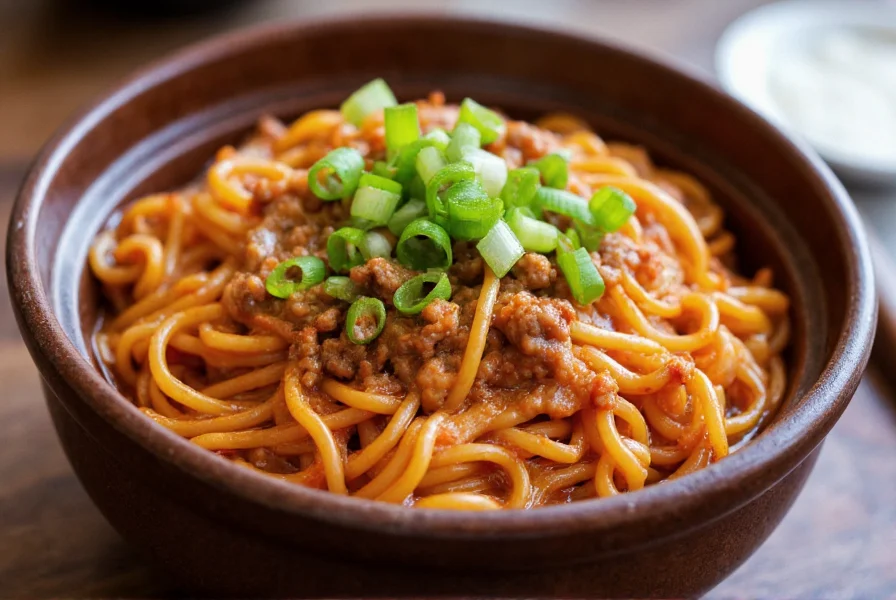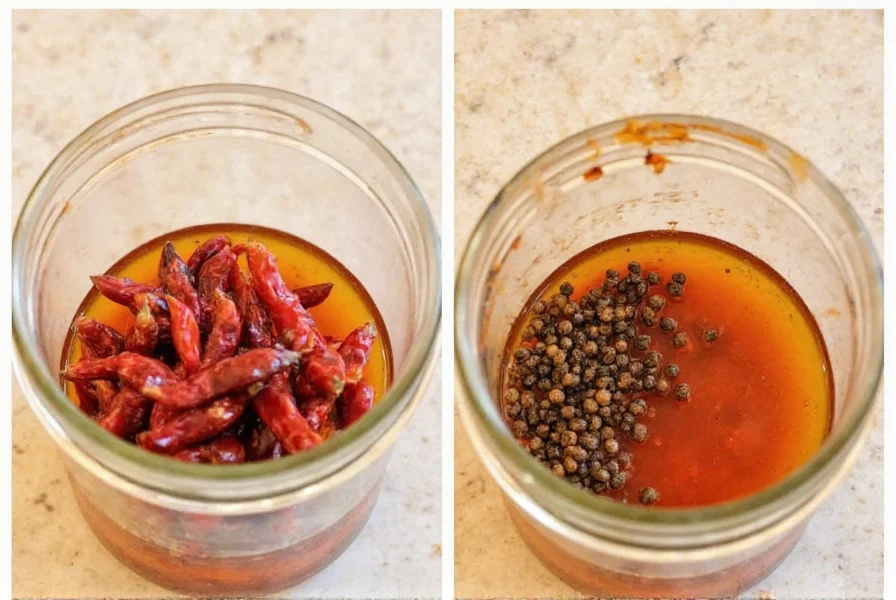Chili noodles represent one of the world's most beloved spicy comfort foods, with roots tracing back to Chinese culinary traditions. What makes this dish so universally appealing is its perfect balance of heat, umami, and texture. Unlike many spicy dishes that rely solely on heat, well-prepared chili noodles offer complex flavor layers that develop as you eat.
The Cultural Journey of Chili Noodles
While chili peppers themselves originated in the Americas, they made their way to Asia through trade routes in the 16th century, revolutionizing local cuisines. In China's Sichuan province, chefs incorporated these fiery peppers into traditional noodle dishes, creating what would become known as zhajiangmian and later evolving into the chili noodles we know today.
As Chinese immigrants traveled worldwide, they brought their culinary traditions with them. In Southeast Asia, chili noodles adapted to local ingredients and preferences, resulting in distinct variations like Singaporean chili crab noodles and Thai nam tok noodles. In Western countries, chili noodles have become a staple in Asian fusion cuisine, with chefs experimenting with local ingredients while maintaining the dish's essential spicy character.

Regional Variations of Chili Noodles
Understanding the different regional takes on chili noodles helps home cooks appreciate the dish's versatility. Each variation brings unique ingredients and preparation methods that reflect local culinary traditions.
| Regional Variation | Key Characteristics | Signature Ingredients |
|---|---|---|
| Sichuan Chili Oil Noodles | Numbing-spicy flavor profile, bold red color | Chili oil, Sichuan peppercorns, fermented black beans |
| Singaporean Chili Crab Noodles | Sweet-spicy tomato-based sauce, seafood-forward | Chili-tomato sauce, crab meat, tamarind |
| Thai Nam Tok Noodles | Herbaceous, citrusy, with meat broth base | Fresh herbs, lime juice, roasted rice powder |
| Japanese Tan Tan Men | Creamy spicy broth, ramen-style noodles | Sesame paste, ground pork, chili oil |
Essential Components of Perfect Chili Noodles
Creating exceptional chili noodles requires attention to three critical elements: the noodles themselves, the chili sauce base, and the toppings that complete the dish.
Noodle Selection Matters
The foundation of any great chili noodle dish is the noodle itself. While wheat noodles are traditional, modern variations use rice noodles, egg noodles, or even zucchini noodles for dietary preferences. The key is matching the noodle's texture to the sauce's consistency:
- Fresh wheat noodles (alkaline noodles) work best for saucy preparations as they absorb flavors while maintaining chewiness
- Dried ramen noodles provide excellent texture contrast in broth-based chili noodle soups
- Rice noodles are ideal for Southeast Asian variations where a lighter, less chewy texture is preferred
Building the Perfect Chili Sauce
The sauce makes or breaks chili noodles. Professional chefs emphasize layering flavors rather than relying solely on heat. Start with a base of garlic and ginger sautéed in oil, then add:
- Chili paste or fresh chilies (adjust quantity based on desired heat level)
- Soy sauce or tamari for umami depth
- Vinegar or citrus for brightness
- Sweetener (honey, sugar, or mirin) to balance heat
- Optional thickener like cornstarch slurry for clingy sauce

Step-by-Step Guide to Making Restaurant-Quality Chili Noodles at Home
Follow this professional technique to create impressive chili noodles that rival your favorite restaurant's version. This method for authentic Sichuan-style chili oil noodles requires minimal specialized equipment but delivers maximum flavor.
Ingredients for Two Servings
- 200g fresh wheat noodles or 140g dried noodles
- 3 tbsp chili oil (homemade preferred)
- 1 tbsp soy sauce
- 1 tsp black vinegar or rice vinegar
- 1 tsp sugar
- 1 clove garlic, minced
- ½ tsp Sichuan peppercorns, toasted and ground
- 2 green onions, finely sliced
- Optional: 100g ground pork or tofu for protein
Preparation Method
- Bring a large pot of water to boil and cook noodles according to package directions, aiming for al dente texture
- While noodles cook, prepare sauce by combining chili oil, soy sauce, vinegar, sugar, and minced garlic in a large mixing bowl
- If using protein, cook ground pork or tofu in a separate pan until browned, then set aside
- Drain cooked noodles, reserving ¼ cup of noodle water
- Immediately add hot noodles to the sauce bowl and toss vigorously to coat evenly
- If sauce seems too thick, add reserved noodle water one tablespoon at a time until desired consistency
- Transfer to serving bowls and top with protein (if using), ground Sichuan peppercorns, and green onions
- Serve immediately while hot for the best texture and flavor experience
Avoiding Common Chili Noodle Mistakes
Even experienced home cooks make these frequent errors when preparing chili noodles. Learning to avoid them will significantly improve your results:
- Overcooking noodles - Noodles should have slight resistance when bitten (al dente). Overcooked noodles become mushy and won't hold sauce properly
- Using cold noodles with sauce - Always toss hot noodles directly with room-temperature sauce; the heat helps emulsify the sauce and coat noodles evenly
- Ignoring the importance of chili oil quality - Store-bought chili oil often lacks complexity. Consider making your own by infusing oil with dried chilies and aromatics
- Adding all sauce ingredients at once - Layer flavors by sautéing aromatics first, then building sauce components sequentially
- Skipping the resting time - Let prepared chili noodles sit for 2-3 minutes before serving to allow flavors to meld
Customizing Chili Noodles for Different Dietary Needs
One reason chili noodles have gained global popularity is their adaptability to various dietary requirements without sacrificing flavor:
- Vegetarian/Vegan - Substitute meat with mushrooms, tofu, or textured vegetable protein; use mushroom broth instead of meat-based broths
- Gluten-free - Choose rice noodles or gluten-free wheat alternatives; replace soy sauce with tamari or coconut aminos
- Lower-carb - Use spiralized vegetables like zucchini or sweet potato as noodle substitutes
- Milder versions for children - Reduce chili content and increase sweetness; serve chili oil on the side for adults to add
Storing and Reheating Leftover Chili Noodles
While chili noodles are best enjoyed fresh, proper storage techniques can maintain quality for leftovers:
- Store components separately when possible - noodles, sauce, and toppings in different containers
- Keep noodles lightly coated with oil to prevent sticking
- Refrigerate for up to 3 days or freeze sauce components for up to 2 months
- When reheating, use a splash of water or broth and stir-fry rather than microwaving for best texture
- Avoid reheating more than once to maintain food safety and quality
Perfect Pairings for Your Chili Noodle Meal
Complete your chili noodle experience with these complementary dishes that balance the meal's heat and intensity:
- Cooling cucumber salad with sesame dressing
- Steamed jasmine rice to temper the spiciness
- Light vegetable stir-fry with bok choy or gai lan
- Refreshing Asian pear or watermelon slices for dessert
- Cold jasmine tea or barley tea to drink
Conclusion: The Enduring Appeal of Chili Noodles
Chili noodles continue to captivate food lovers worldwide because they perfectly balance simplicity with complexity. At their core, they require few ingredients but offer endless customization possibilities. Whether you're craving a quick weeknight dinner or an authentic taste of Asian culinary tradition, mastering chili noodles provides a versatile skill that serves you well in the kitchen. The key to exceptional chili noodles lies not in extreme heat but in the harmony of flavors—spicy, savory, sweet, and tangy elements working together to create a satisfying culinary experience.
Frequently Asked Questions
What's the difference between chili oil noodles and dan dan noodles?
While both dishes feature spicy noodles, chili oil noodles primarily rely on chili oil for heat and flavor, typically served with minimal broth. Dan dan noodles originate from Sichuan cuisine and feature a sauce made with fermented black beans, chili oil, and ground meat, traditionally served with a small amount of broth. Dan dan noodles also typically include Sichuan peppercorns for the characteristic numbing sensation, while chili oil noodles focus more on straightforward heat.
How can I make chili noodles less spicy without losing flavor?
To reduce spiciness while maintaining flavor in chili noodles, try these techniques: add a small amount of sugar or honey to balance heat, incorporate creamy elements like sesame paste or peanut butter, increase the vinegar content for brightness that distracts from heat, or add more umami-rich ingredients like soy sauce or mushrooms. You can also remove seeds from fresh chilies before using them, or use milder chili varieties like ancho instead of hotter options like bird's eye chilies.
What's the secret to making restaurant-quality chili oil at home?
The secret to exceptional homemade chili oil involves multiple temperature stages and quality ingredients. Start with high-quality dried chilies (a mix of mild and hot varieties), toasted Sichuan peppercorns, and aromatics like garlic and ginger. Heat neutral oil to 250°F (120°C), then pour slowly over the chili mixture in stages - first a small amount to bloom flavors, then the remainder after cooling slightly to 200°F (95°C). Let steep for 24 hours before straining. The layered heating process extracts different flavor compounds at optimal temperatures for maximum complexity.
Can I prepare chili noodles ahead of time for meal prep?
Yes, chili noodles work well for meal prep with proper technique. Store components separately: cook noodles to just under al dente, rinse in cold water, and toss with a small amount of oil to prevent sticking. Keep sauce components in a separate container. When ready to eat, quickly reheat noodles in boiling water for 30 seconds, drain, then toss with room-temperature sauce. This method preserves texture better than storing fully assembled noodles, which become soggy. Properly stored, components will last 3-4 days in the refrigerator.











 浙公网安备
33010002000092号
浙公网安备
33010002000092号 浙B2-20120091-4
浙B2-20120091-4